#pibo
Photo
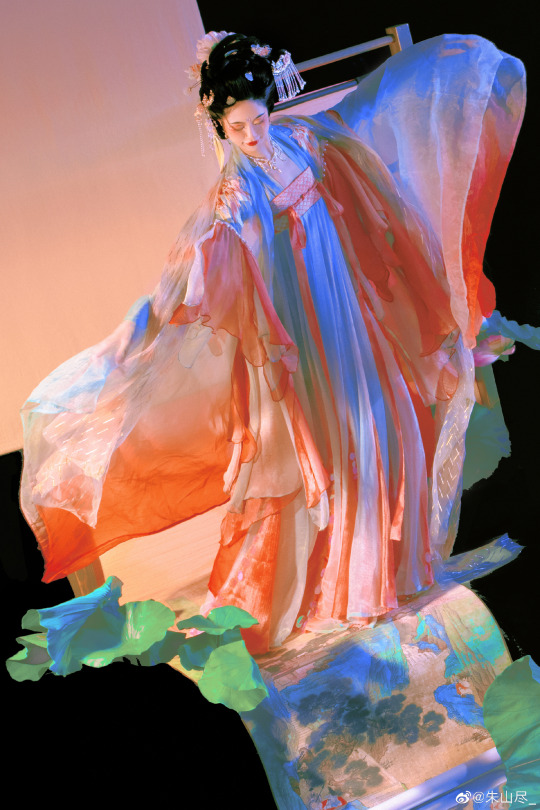

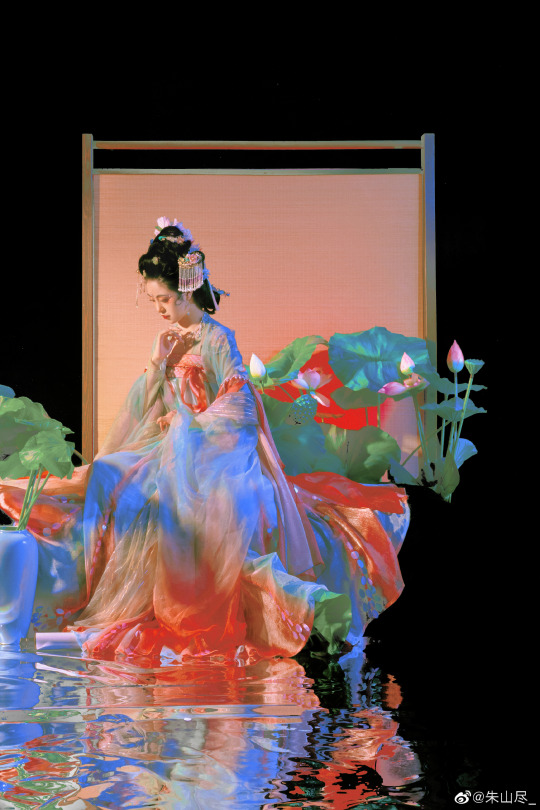
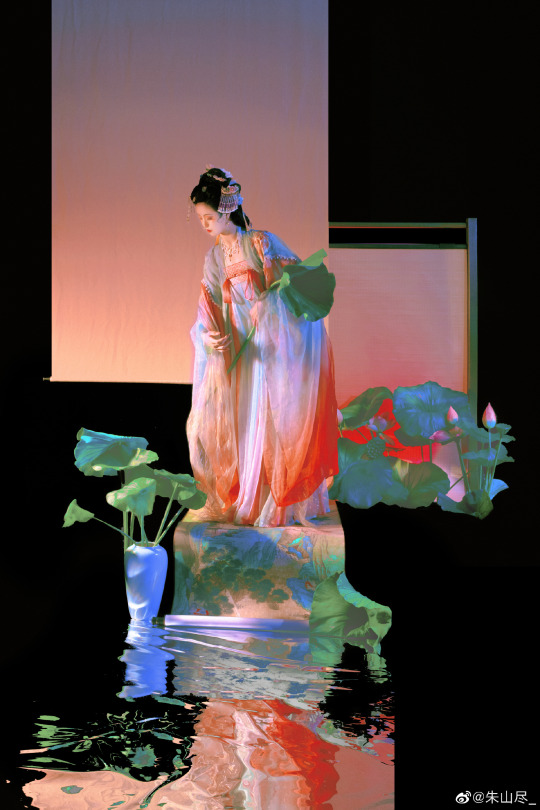

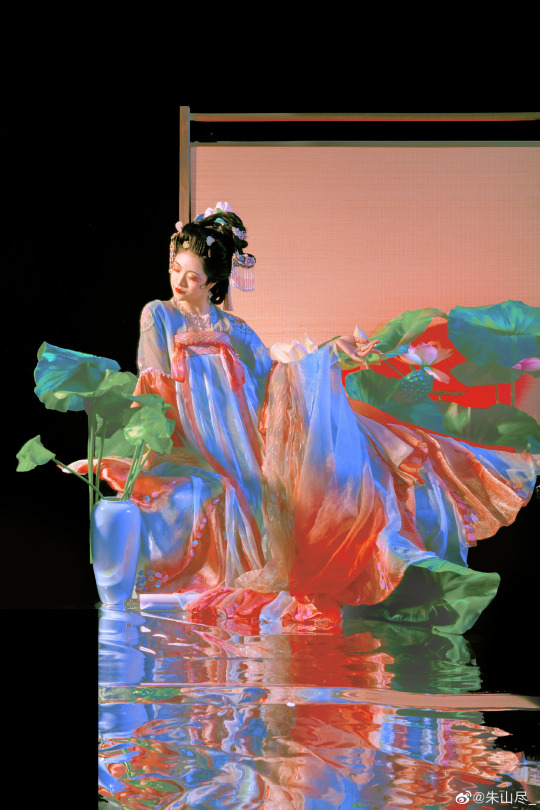

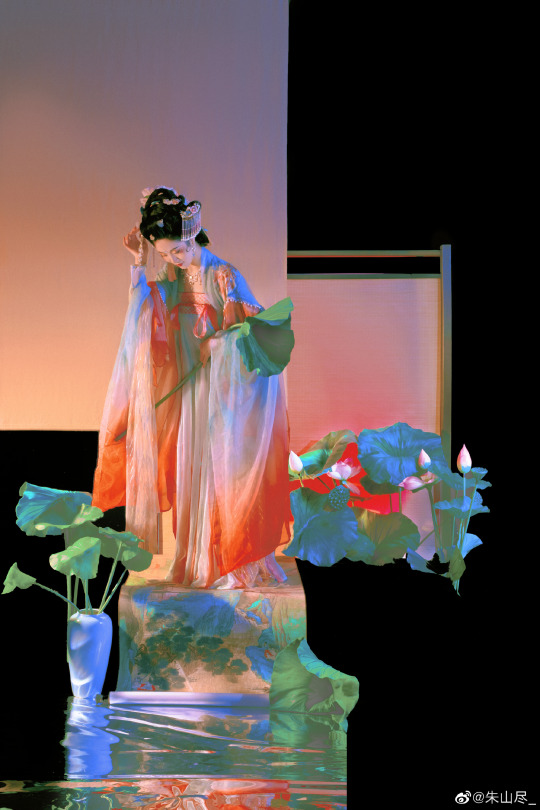

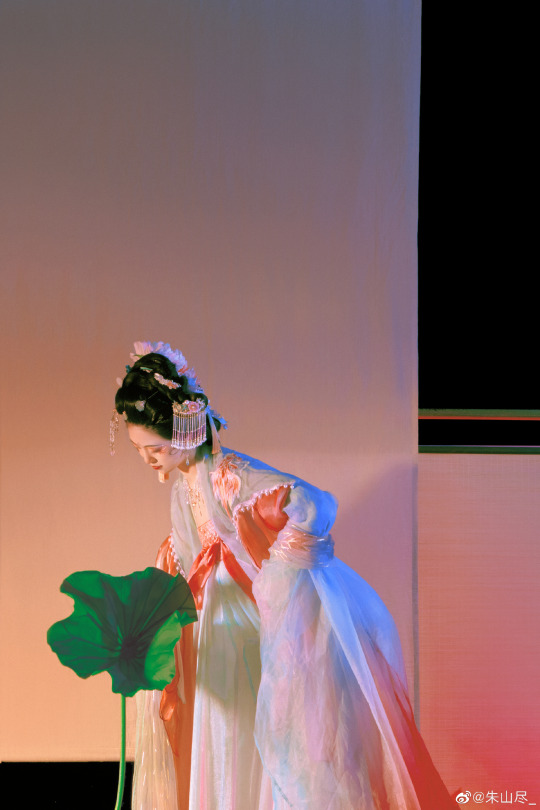

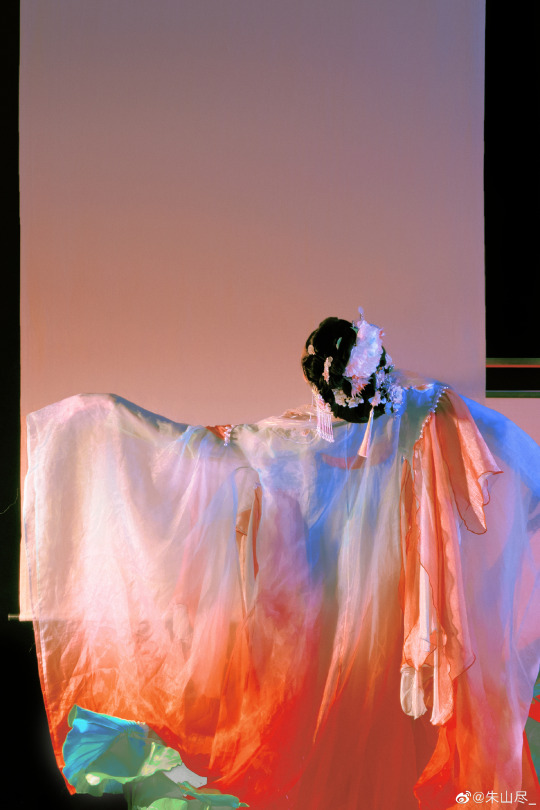
[Hanfu・漢服]Chinese Tang Dynasty Hanfu Photoshoots
我曾在春夜中梦到过一尾锦鲤
I once dreamed of a koi on a spring night
————————
📸Photo:@朱山尽_
👗Hanfu:@子颂东方美学游园惊梦
💄Makeup∶ @南夕叙
🧚🏻♀️Model:@如烟(Xiaohongshu App)
🔗Weibo:https://weibo.com/6906018733/MuwZx3RWT
————————
#Chinese hanfu#Tang Dynasty#hanfu photoshoot#hanfu#hanfu art#hanfu accessories#Chinese Costume#Chinese Aesthetics#Chinese Style#hanfu fashion#汉元素#朱山尽#子颂东方美学游园惊梦#南夕叙#如烟#ruqun#pibo#漢服#汉服
437 notes
·
View notes
Note
Hello this might be a silly question but I genuinely wonder if the Pi Bo and Pi Feng can be worn together?
Hi! Thanks for the question, and sorry for taking ages to reply!
Historically, 披帛/pibo and 披风/pifeng would not have been worn together, as they are from different time periods.
As I explained in my post on pibo here, the pibo - a scarf-like accessory - first appeared sometime around the Qin dynasty, really came into vogue during the Sui & Tang dynasties, and fell out of common use during the Song dynasty. Below - Tang dynasty-style pibo (via):
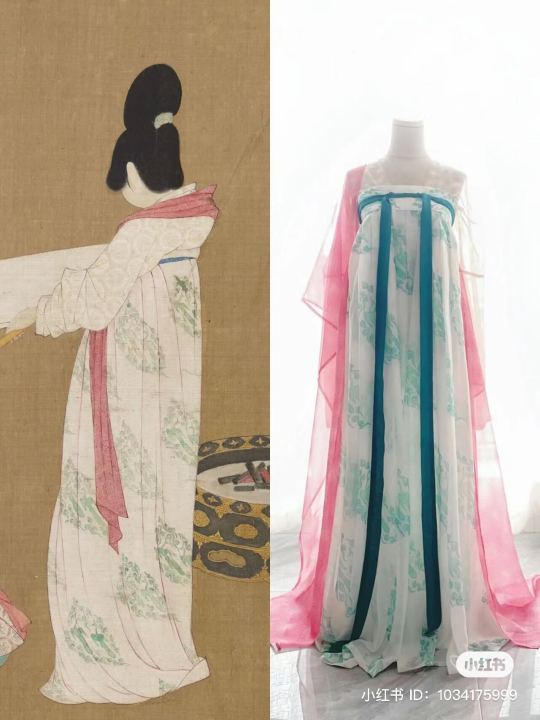
The pibo didn't disappear, though - it just evolved. During the Song dynasty, the pibo evolved into the 霞帔/xiapei. The xiapei became an important component of women's formal attire in the Song, Ming, and Qing dynasties (x). Below - xiapei in Ming dynasty portrait (via):
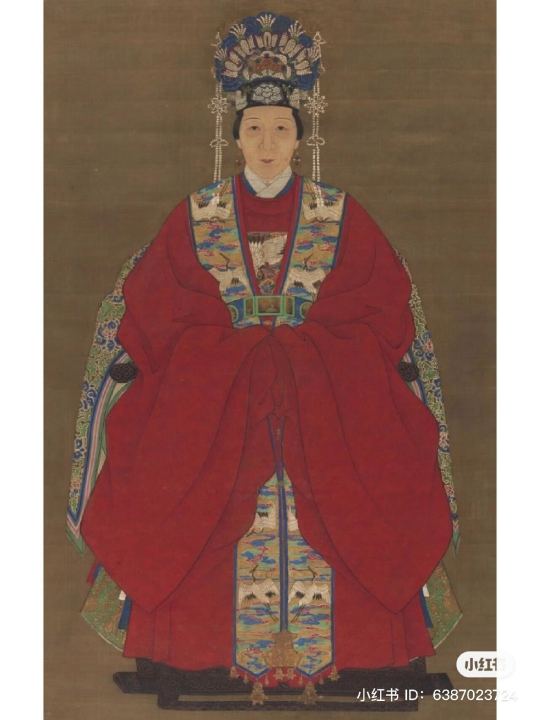
Meanwhile, the pifeng, an outer coat with loose and long sleeves, was worn during the Ming dynasty (pifeng is the Ming dynasty name for beizi). Below - pifeng (via):

So technically, it would be anachronistic to wear the pibo and pifeng together. However, nowadays people are free to mix and match hanfu as they please. Unless you're going for historical accuracy, there's no reason not to wear the pibo and pifeng together if that's what you want ^^
Hope this helps!
#hanfu#pibo#pifeng#xiapei#mix and match#history#ask#reply#reference#>100#chinese fashion#chinese clothing#china#m
105 notes
·
View notes
Photo


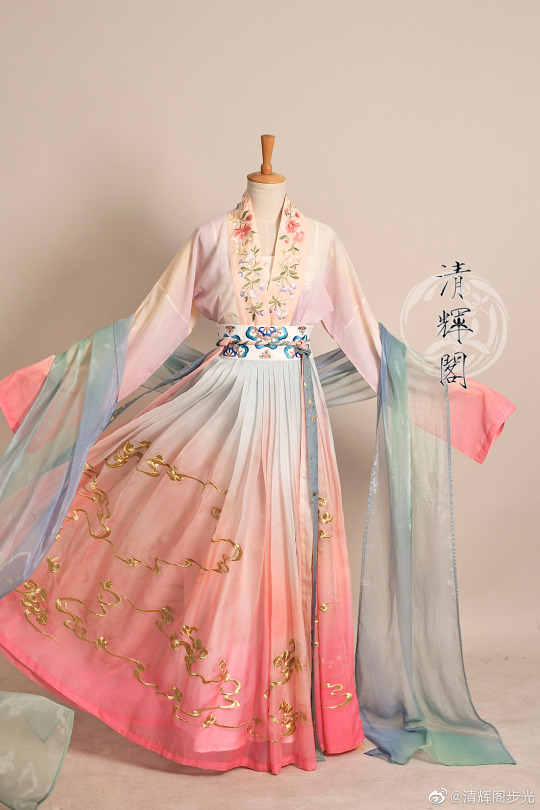
彩云coloured cloud set by 清辉阁
#清辉阁#taobao#hanfu#cloud#embroidery#pibo#qixiong#qiyao#shan#so old school#so good#love the cloud#buy buy buy#but too much for my broken wallet
186 notes
·
View notes
Text
Origins of the Pibo: Let’s take a trip along the Silk Road.
1. Introduction to the garment:
Pibo 披帛 refers to a very thin and long shawl worn by women in ancient East Asia approximately between the 5th to 13th centuries CE. Pibo is a modern name and its historical counterpart was pei 帔. But I’ll use pibo as to not confuse it with Ming dynasty’s xiapei 霞帔 and a much shorter shawl worn in ancient times also called pei.
Below is a ceramic representation of the popular pibo.
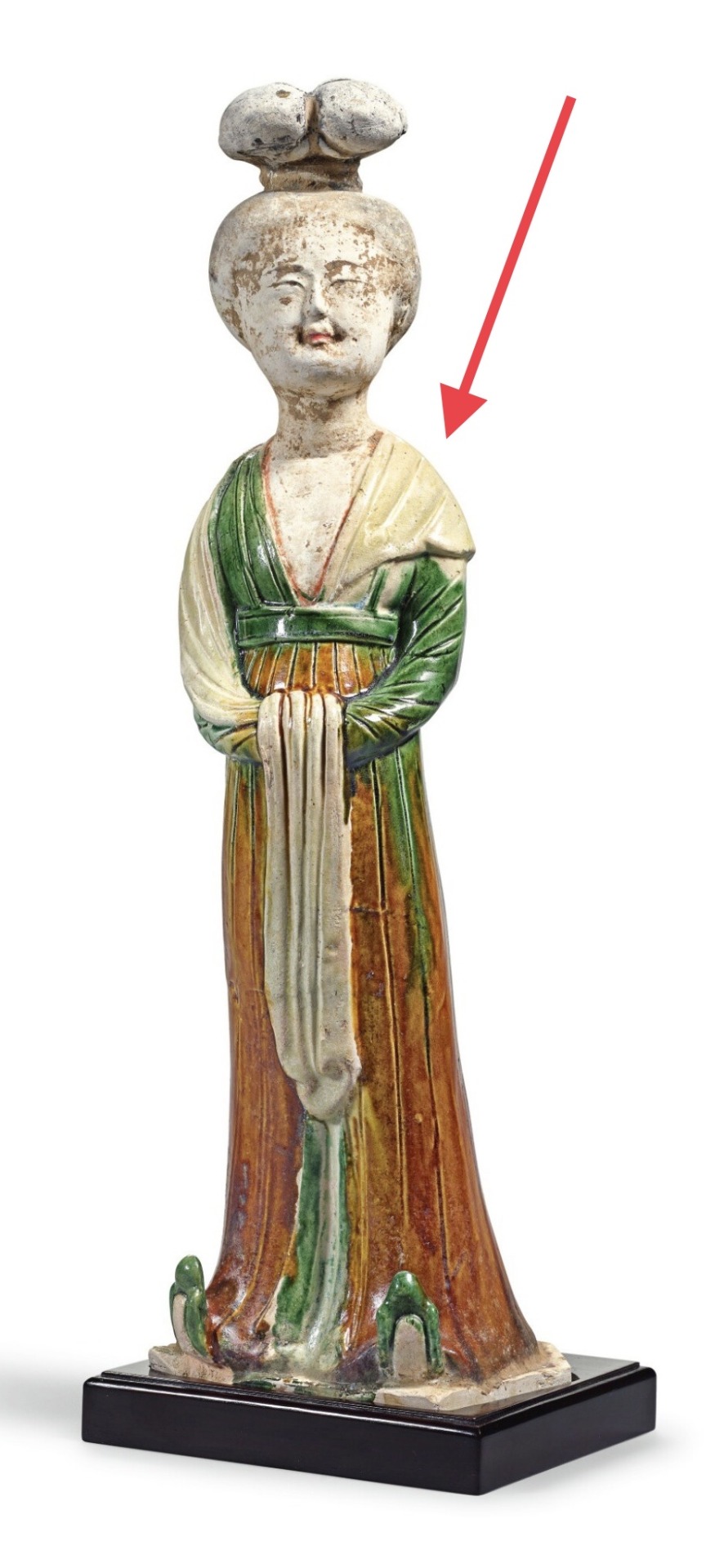
A sancai-glazed figure of a court lady, Tang Dynasty (618–690, 705–907 CE) from the Sze Yuan Tang Collection. Artist unknown. Sotheby’s [image source].
Although some internet sources claim that pibo in China can be traced as far back as the Qin (221-206 BCE) or Han (202 BCE–9 CE; 25–220 CE) dynasties, we don’t start seeing it be depicted as we know it today until the Northern and Southern dynasties period (420-589 CE). This has led to scholars placing pibo’s introduction to East Asia until after Buddhism was introduced in China. Despite the earliest art representations of the long scarf-like shawl coming from the Northern and Southern Dynasties period, the pibo reached its popularity apex in the Tang Dynasty (618–690 CE: 705–907 CE).
Academic consensus: Introduction via the Silk Road.
The definitive academic consensus is that pibo evolved from the dajin 搭巾 (a long and thin scarf) worn by Buddhist icons introduced to China via the Silk Road from West Asia.
披帛是通过丝绸之路传入中国的西亚文化, 与中国服饰发展的内因相结合而流行开来的一种"时世妆" 的形式. 沿丝绸之路所发现的披帛, 反映了丝绸贸易的活跃.
[Trans] Pibo (a long piece of cloth covering the back of the shoulders) was a popular female fashion period accessory introduced to China by West Asian cultures by way of the Silk Road and the development of Chinese costumes. The brocade scarves found along the Silk Road reflect the prosperity of the silk trade that flourished in China's past (Lu & Xu, 2015).
I want to add to the above theory my own speculation that, what the Chinese considered to be dajin, was most likely an ancient Indian garment called uttariya उत्तरीय.
2. Personal conjecture: Uttariya as a tentative origin to pibo.
In India, since Vedic times (1500-500 BCE), we see mentions in records describing women and men wearing a thin scarf-like garment called “uttariya”. It is a precursor of the now famous sari. Although the most famous depiction of uttariya is when it is wrapped around the left arm in a loop, we do have other representations where it is draped over the shoulders and cubital area (reverse of the elbow).
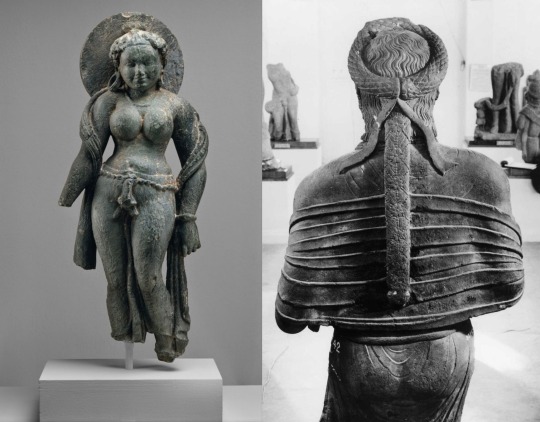
Left: Hindu sculpture “Mother Goddess (Matrika)”, mid 6th century CE, gray schist. Artist unknown. Looted from Rajasthan (Tanesara), India. Photo credit to Metropolitan Museum of Art, New York, United States [image source].
Right: Rear view of female statue possibly representing Kambojika, the Chief Queen of Mahakshatrapa Rajula, ca. 1st century CE. Artist unknown. Found in the Saptarishi Mound, Mathura, India. Government Museum, Mathura [image source].
Buddhism takes many elements from Hindu mythology, including apsaras अप्सरा (water nymphs) and gandharvas गन्धर्व (celestial musicians). The former was translated as feitian 飞天 in China. Hindu deities were depicted wearing clothes similar to what Indian people wore, among which we find uttariya, often portrayed in carvings and sculptures of flying and dancing apsaras or gods to show dynamic movement. Nevertheless, uttariya long predated Buddhism and Hinduism.
Below are carved representation of Indian apsaras and gandharvas. Notice how the uttariya are used.

Upper left: Carved relief of flying celestials (Apsara and Gandharva) in the Chalukyan style, 7th century CE, Chalukyan Dynasty (543-753 CE). Artist Unknown. Aihole, Karnataka, India. National Museum, New Delhi, India [image source]. The Chalukyan art style was very influential in early Chinese Buddhist art.
Upper right: Carved relief of flying celestials (gandharvas) from the 10th to the 12th centuries CE. Artist unknown. Karnataka, India. National Museum, New Delhi, India [image source].
Bottom: A Viyadhara (wisdom-holder; demi-god) couple, ca. 525 CE. Artist unknown. Photo taken by Nomu420 on May 10, 2014. Sondani, Mandsaur, India [image source].
Below are some of the earliest representations of flying apsaras found in the Mogao Caves, Gansu Province, China. An important pilgrimage site along the Silk Road where East and West met.
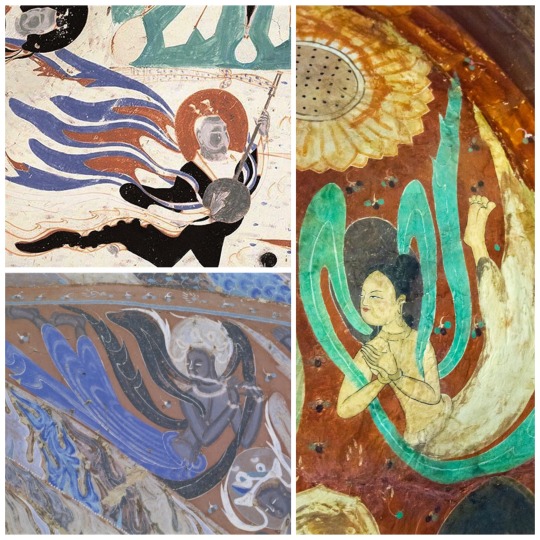
Left to right: Cave No. 461, detail of mural in the roof of the cave depicting either a flying apsara or a celestial musician. Western Wei dynasty (535–556 CE). Artist unknown. Mogao Grottoes, Dunhuang, China [image source].
Cave 285 flying apsara (feitian) in one of the Mogao Caves. Western Wei Dynasty (535–556 CE), Artist unknown. Photo taken by Keren Su for Getty Images. Mogao Grottoes, Dunhuang, China [image source].
Cave 249. Mural painting of feitian playing a flute, Western Wei Dynasty (535-556 CE). Image courtesy by Wang Kefen from The Complete Collection of Dunhuang Grottoes, Vol. 17, Paintings of Dance, The Commercial Press, Hong Kong, 2001, p. 15. Mogao Grottoes, Dunhuang, China [image source].
I theorize that it is likely that the pibo was introduced to China via Buddhism and Buddhist iconography that depicted apsaras (feitian) and other deites wearing uttariya and translated it to dajin.
3. Trickle down fashion: Buddhism’s journey to the East.
However, since Buddhism and its Indian-based fashion spread to West Asia first, to Sassanian Persians and Sogdians, it is likely that, by the time it reached the Han Chinese in the first century CE, it came with Persian and Sogdian influence. Persians’ fashion during the Sassanian Empire (224–651 CE) was influenced by Greeks (hellenization) who also had a a thin long scarf-like garment called an epliblema ἐπίβλημα, often depicted in amphora (vases) of Greek theater scenes and sculptures of deities.

Left to right: Dame Baillehache from Attica, Greece. 3rd century BCE, Hellenistic period (323-30 BCE), terracotta statuette. Photo taken by Hervé Lewandowski. Louvre Museum, Paris, France [image source].
Deatail view of amphora depicting the goddess Artemis by Athenian vase painter, Andokides, ca. 525 BCE, terracotta. Found in Vulci, Italy. Altes Museum, Berlin, Germany [image source].
Statue of a Kore (young girl), ca. 570 BCE, Archaic Period (700-480 BCE), marble. Artist unknown. Uncovered from Attica, Greece. Acropolis Museum, Athens, Greece [image source].
Detail view of Panathenaic (Olympic Games) prize amphora with lid, 363–362 BCE, Attributed to the Painter of the Wedding Procession and signed by Nikodemos, terracotta. Uncovered from Athens, Greece. J. Paul Getty Museum, Los Angeles, California, United States [image source].
Roman statue depicting Euterpe, muse of lyric poetry and music, ca. 2nd century CE, marble, Artist unknown. From the Villa of G. Cassius Longinus near Tivoli, Italy. Photo taken by Egisto Sani on March 12, 2012, Vatican Museums, Rome, Italy [image source].
Greek (or Italic) tomb mural painting from the Tomb of the Diver, ca. 470 BCE, fresco. Artist unknown. Photo taken by Floriano Rescigno. Necropolis of Paestum, Italy [image source].
Below are Iranian and Iraqi period representations of this long thin scarf.

Left to right: Closeup of ewer likely depicting a female dancer from the Sasanian Period (224–651 CE) in ancient Persia , Iran, 6th-7th century CE, silver and gilt. Artist unknown. Mary Harrsch. July 10, 2015. Arthur M. Sackler Gallery of Asian Art, Smithsonian, Washington D.C [image source].
Ewer with nude dancer probably representing a maenad, companion of Dionysus from the Sasanian Period (224–651 CE) in ancient Persia, Iran, 6th-7th century CE, silver and gilt. Artist unknown. Mary Harrsch. July 16, 2015. Arthur M. Sackler Gallery of Asian Art, Smithsonian, Washington D.C [image source].
Painting reconstructing the image of unveiled female dancers depicted in a fresco, Early Abbasid period (750-1258 CE), about 836-839 CE from Jawsaq al-Khaqani, Samarra, Iraq. Museum of Turkish and Islamic Art, Istanbul [image source].
The earliest depictions of Buddha in China, were very similar to West Asian depictions. Ever wonder why Buddha wears a long draped robe similar to a Greek himation (Romans called it toga)?
Take a look below at how much the Greeks influenced the Kushans in their art and fashion. The top left image is one of the earliest depictions of Buddha in China. Note the similarities between it and the Gandhara Buddha on the right.
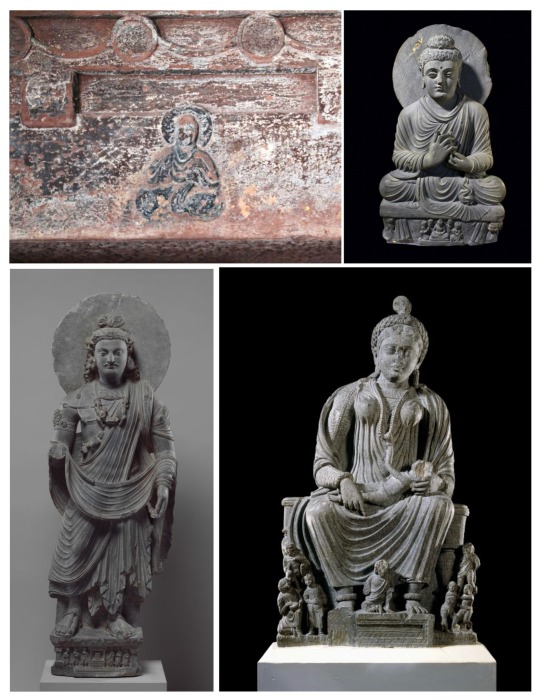
Left: Seated Buddha, Mahao Cliff Tomb, Sichuan Province, Eastern Han Dynasty, late 2nd century C.E. (photo: Gary Todd, CC0).
Right: Seated Buddha from Gandhara, Pakistan c. 2nd–3rd century C.E., Gandhara, schist (© Trustees of the British Museum)
Standing Bodhisattva Maitreya (Buddha of the Future), ca. 3rd century, gray schist. From Gandhara, Pakistan. Image credit to The Metropolitan Museum of Art, New York City, United States [image source].
Statue of seated goddess Hariti with children, ca. 2nd to 3rd centuries CE, schist. Artist unknown. From Gandhara, Pakistan. The British Museum, London, England [image source].
Before Buddhism spread outside of Northern India (birthplace), Indians never portrayed Buddha in human form.
Early Buddhist art is aniconic, meaning the Buddha is not represented in human form. Instead, Buddha is represented using symbols, such as the Bodhi tree (where he attained enlightenment), a wheel (symbolic of Dharma or the Wheel of Law), and a parasol (symbolic of the Buddha’s royal background), just to name a few. […] One of the earliest images [of Buddha in China] is a carving of a seated Buddha wearing a Gandharan-style robe discovered in a tomb dated to the late 2nd century C.E. (Eastern Han) in Sichuan province. Ancient Gandhara (located in present-day Afghanistan, Pakistan, and northwest India) was a major center for the production of Buddhist sculpture under Kushan patronage. The Kushans occupied portions of present-day Afghanistan, Pakistan, and North India from the 1st through the 3rd centuries and were the first to depict the Buddha in human form. Gandharan sculpture combined local Greco-Roman styles with Indian and steppe influences (Chaffin, 2022).
In the Mogao Caves, which contain some of the earliest Buddhist mural paintings in China, we see how initial Chinese Buddhist art depicted Indian fashion as opposed to the later hanfu-inspired garments.

Left to right: Cave 285, detail of wall painting, Western Wei dynasty (535–556 CE). Mogao Grottoes, Dunhuang, China. Courtesy the Dunhuang Academy [image source]. Note the clothes the man is wearing. It looks very similar to a lungi (a long men’s skirt).
Photo of Indian man sitting next to closed store wearing shirt, scarf, lungi and slippers. Paul Prescott. February 20, 2015. Varanasi, India [image source].
Cave 285, mural depiction of worshipping bodhisattvas, 6th century CE, Wei Dynasty (535-556 A.D.), Unknown artist. Mogao Grottoes, Dunhuang, China. Notice the half bow on his hips. That is a common style of tying patka (also known as pataka; cloth sashes) that we see throughout Indian history. Many of early Chinese Buddhist paintings feature it, including the ones at Mogao Caves.
Indian relief of Ashoka wearing dhoti and patka, ca. 1st century BC, Unknown artist. From the Amaravathi village, Guntur district, Andhra Pradesh, India. Currently at the Guimet Museum, Paris [image source].
Cave 263. Mural showing underlying painting, Northern Wei Dynasty (386–535 CE). Artist Unknown. Picture taken November 29, 2011, Mogao Grottoes, Dunhuang, China [image source]. Note the pants that look to be dhoti.
Comparison photo of modern dhoti advertisement from Etsy [image source].
Spread of Buddhism to East Asia.

Map depicting the spread of Buddhism from Northern India to the rest of Asia. Gunawan Kartapranata. January 31, 2014 [image source]. Note how Mahayana Buddhism arrived to China after passing through Kushan, Bactrean, and nomadic steppe lands, absorbing elements of each culture along the way.
Wealthy Buddhist female patrons emulated the fantasy fashion worn by apsaras, specifically, the uttariya/dajin and adopted it as an everyday component of their fashion.

Cave 285. feitian mural painting on the west wall, Western Wei Dynasty (535–556 CE). Artist unknown. Mogao Grottoes, Dunhuang, China [image source].
Cave 285. Detail view of offering bodhisattvas (bodhisattvas making offers to Buddha) next to the phoenix chariot on the Western wall of the cave. Western Wei Dynasty (535–556 CE). Artist unknown. Mogao Grottoes, Dunhuang, China [image source].
Cave 61 Khotanese (from the kingdom of Khotan 于阗 [56–1006 CE]) donor ladies, ca. 10th century CE, Five Dynasties period (907 to 979 CE). Artist unknown. Picture scanned from Zhang Weiwen’s Les oeuvres remarquables de l'art de Dunhuang, 2007, p. 128. Uploaded to Wikimedia Commons on October 11, 2012 by Ismoon. Mogao Grottoes, Dunhuang, China [image source].
Detail view of Ladies Adorning Their Hair with Flowers 簪花仕女图, late 8th to early 9th century CE, handscroll, ink and color on silk, Zhou Fang 周昉 (730-800 AD). Liaoning Provincial Museum, Shenyang, China [image source].
Therefore, the theory I propose of how the pibo entered East Asia is:
India —> Greek influenced West Asia (Sassanian Persians, Sogdians, Kushans, etc…) —> Han China —> Rest of East Asia (Three Kingdoms Korea, Asuka Japan, etc…)
Thus, the most likely theory, in my person opinion, is Buddhist iconography depicting uttariya encountered Greek-influenced West Asian Persian, Sogdian, and Kushan shawls, which combined arrived to China but wouldn’t become commonplace there until the explosion in popularity of Buddhism from the periods of Northern and Southern Dynasties to Song.
References:
盧秀文; 徐會貞. 《披帛與絲路文化交流》 [The brocade scarf and the cultural exchanges along the Silk Road]. 敦煌研究 (中國: 敦煌研究編輯部). 2015-06: 22 – 29. ISSN 1000-4106.
#hanfu#chinese culture#chinese history#buddhism#persian#sogdian#kushan#gandhara#indian fashion#uttariya#pibo#history#asian culture#asian art#asian history#asian fashion#east asia#south asia#india#pakistan#iraq#afghanistan#sassanian#silk road#fashion history#tang dynasty#eastern han dynasty#cultural exchange#greek fashion#mogao caves
283 notes
·
View notes
Text
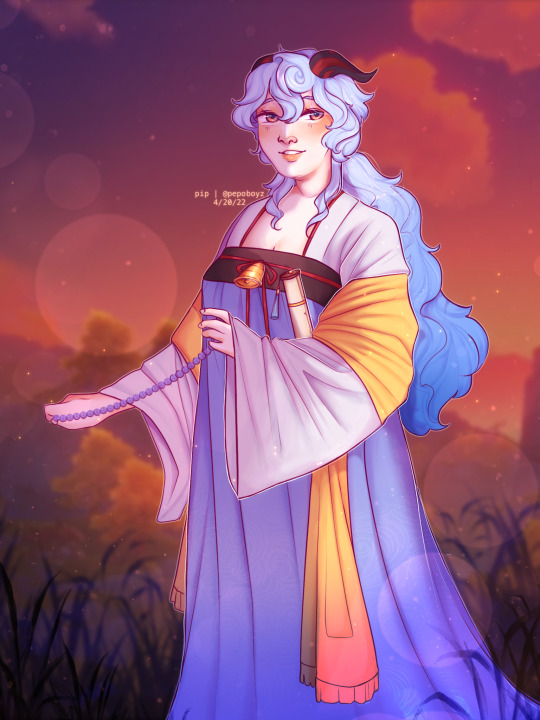
ganyu genshinimpact in hanfu! i made this during tech week of a musical i was in months ago. i cant remember how lomg this took lmao
73 notes
·
View notes
Photo


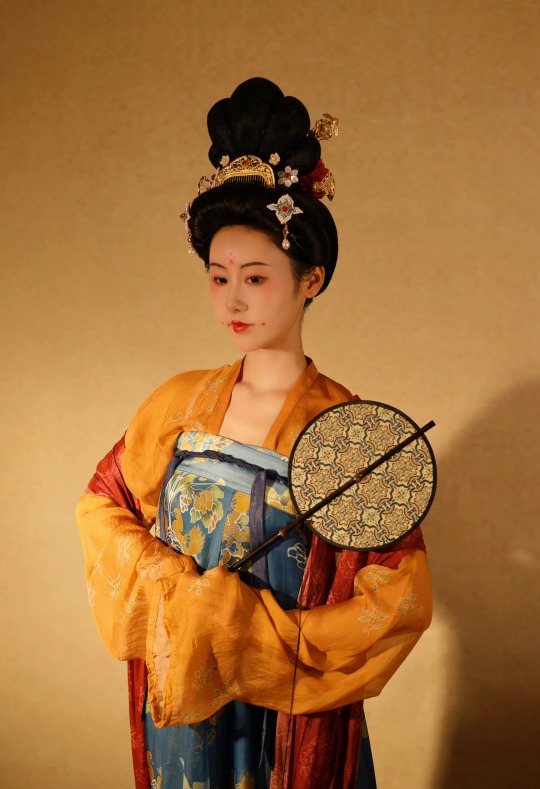

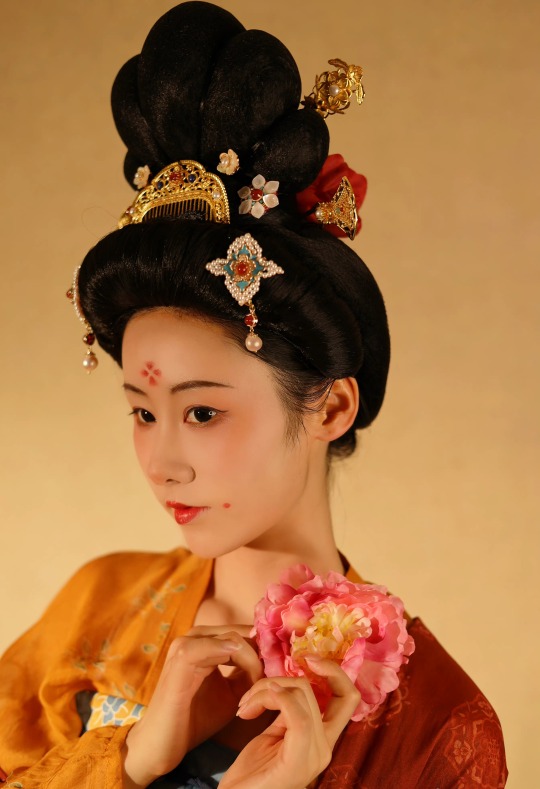

人间月-素尘
123 notes
·
View notes
Text
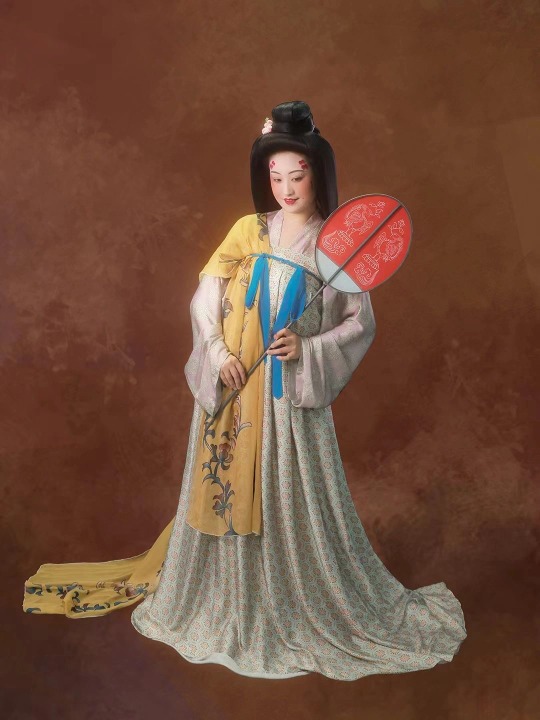




Traditional Tang Dynasty Costume Styling
From Hanfu Photographer: Si Si (丝丝)
91 notes
·
View notes
Text
uploaded: may 2, 2016
[youtube upload] [nnd upload]
5 notes
·
View notes
Text
EPR Registration for Plastic Waste | Managing Our Environmental Footprint

View On WordPress
#EPR Authorization#epr certificate#epr consultant#epr for plastic waste#epr license#epr registration#pibo
0 notes
Text
god theres really something about utaus. listening to poor quality robot voice is sooooo good to my brain
#i love utaus where u cant understand shit and i love utaus where they sound clear but still computery#also theres one song ive found where its a conversation between the voice provider and their utau which is SO COOL#becuase by pibo
2 notes
·
View notes
Text
Waste Management And EPR Solutions
#government approved epr agency#EPR registration in gujarat#gujarat epr#EPR in Surat#EPR in Ahmedabad#EPR In Silvasa#Extended producer responsibility in Surat#EPR registration with GPCB#EPR registration for plastic Waste#EPR In Ahmedabad#Extended producer responsibility in Gujarat#EPR services in Kolkata#EPR In daman#EPR in Gujarat#EPR In rajkot#EPR registration with CPCB#EPR Implementation Services near me#PIBOS meaning#Epr plastic manufacturer#Extended producer responsibility in Ahmedabad#gpcb rules for plastic manufacturers#PWM Epr#plastic epr#EPR Action Plan in india#EPR Rule#epr importers#EPR compliance in india#EPR Guidelines#EPR services in hyderabad#EPR under Plastic Waste Management Rules 2016
0 notes
Photo
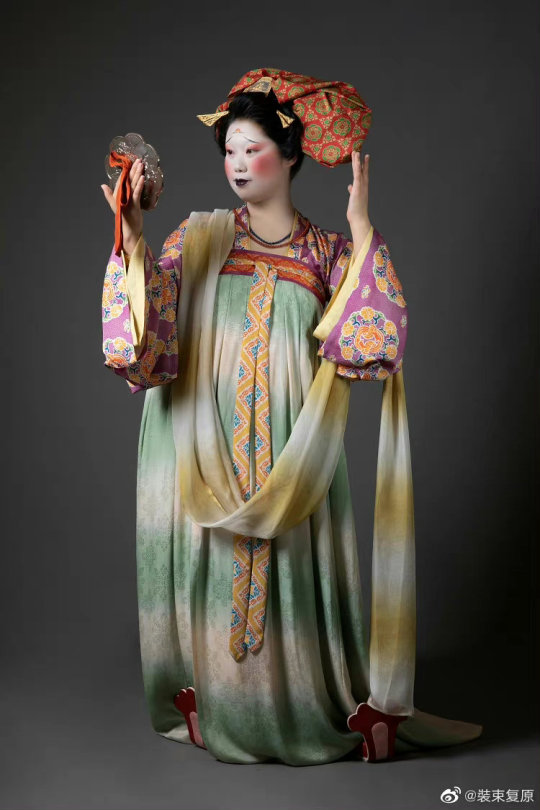

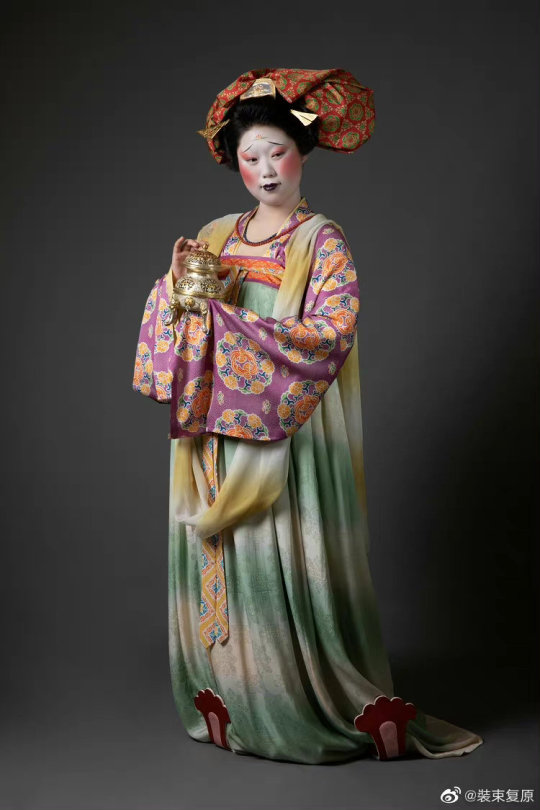


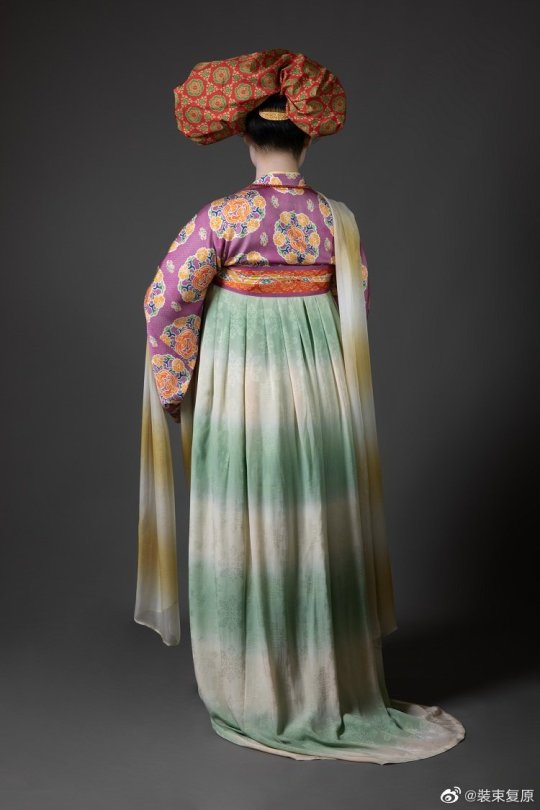
【Reference Tang Dynasty Artifacts】:
・Nao Sao Hairstyle (闹扫髻) Female Figurine, Collection of Wuhan Museum



・Tang Dynasty Female Figurine with Nao Sao Hairstyle (闹扫髻)
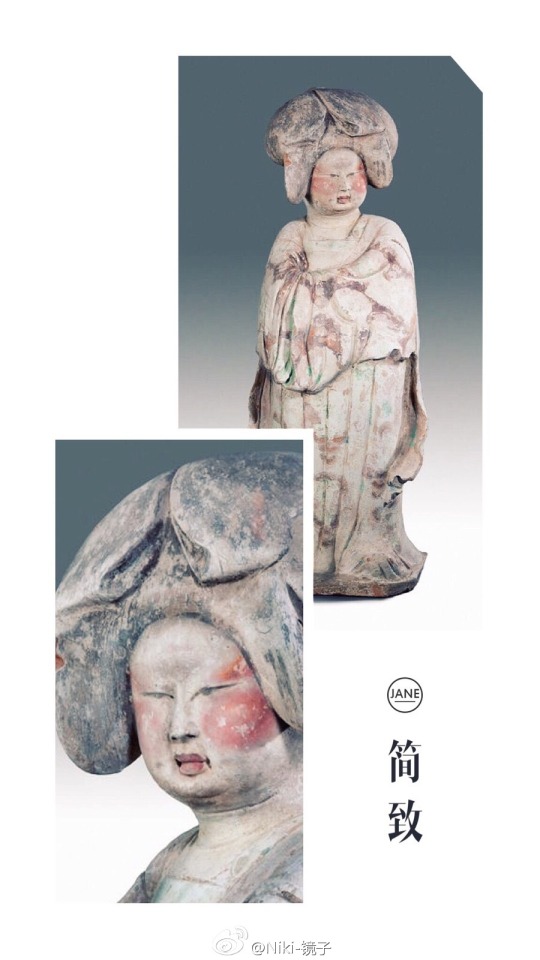
[Hanfu · 漢服]Chinese Tang Dynasty Traditional Clothing Hanfu & Hairstyle Based On Female Figurine-【Late Tang Period】
Women's Clothing, Hairstyle and Makeup in the Late Tang Dynasty
—————-
【History Note】
In the late Tang Dynasty, women's daily attire was still dominated by a combination of shirts (Shan/衫), skirts (Qun/裙), and Pibo (披帛), but compared with the mid-Tang Period, which advocated the sharp silhouette of the upper small and the lower large, the late Tang Period was more fashionable to create a rounded and loose silhouette.
At the same time, the exaggerated and peculiar style in the middle Tang Dynasty is still prosperous. In terms of hairstyle, all kinds of asymmetrical hairstyle are popular, and it is fashionable to wrap the hair bun with various precious fabrics, which has both practical functions and decorative features. “五陵年少争缠头,一曲红绡不知数“”(From the narrative poem "Pipa Xing /琵琶行 “by Bai Juyi in the Tang Dynasty)” is Refers to such attire.
“五陵年少争缠头,一曲红绡不知数”
It refers to "The wealthy children of the capital are scrambling to give me rewards, and every time a song (play pipa) is played, I will got countless beautiful brocades (红绡)
About the makeup, as Tang Dynasty poet Bai Juyi, described in his poem "Shishi Zhuang/时世妆" :”乌膏注唇唇似泥,双眉画作八字低”
The black cream is applied to the lips and lips are like mud, and the eyebrows are painted with low “八 (chinese character "eight")”shape.
This is a popular makeup look in the mid-Tang Period and it continued to the late Tang.
————————
Recreation Work:@裝束复原
🔗Weibo:https://weibo.com/1656910125/MasyqfRSy
————————
#chinese hanfu#Tang Dynasty#late tang dynasty#Nao Sao Hairstyle#hanfu#hanfu hairstyle#hanfu_challenge#Chinese Costume#chinese traditional clothing#Tang Dynasty Artifacts#chinese historical fashion#chinese history#hanfu history#Nao Sao Hairstyle (闹扫髻) Female Figurine#Pipa Xing /琵琶行#Shishi Zhuang/时世妆#ruqun#shanzi#pibo#Chinese Aesthetics#historical fashion#漢服#汉服#裝束复原
573 notes
·
View notes
Note
:3 anon
tw:nerco(fucking a dead person), kinda angsty, gn ready (you/yours)
OK so after a bit of time, i’ve finally got a grasp on necro. And after a bit of debate i decided to use Zhongli.
reader is from Liyue so they will be wearing a traditional hanfu from the Song Dynasty.
The Archon war left so many nations in shambles and in disarray. You fought so hard for your people. But in the end you couldn’t make it. Zhongli was right beside you when you passed. He made sure to comfort you as you faded from existence. His arms wrapped around you as the light in your eyes faded. He kissed your forehead before kissing your body admiring its beauty. His hands caressed your face and body as he continued to whisper in your ear of your lifeless body about how much he loves you. His hand slowly began to take off your pibo and your beizi from your body. He admired the lovely stitching and designs on the fabric before softly pushing up your Ruqun exposing your body to him. he lays his head down on your body one more to maybe just maybe hear a heartbeat once more. He kisses your wrist and goes up your arm to your lips. His kiss was so tender and genuine as if you were still alive. He began to softly cry and beg for forgiveness from you as he begins to make love with you one last time. It was so soft and gentle. The soft thrusts he did as he cries and says sorry as he kisses your forehead. You felt so cold. His face buried in the crook of your neck to inhale your sent. you smelt like tea and roses. It only fueled his sadness as he continued to fuck your dead body. “F-fuck, i’m so sorry love. I..I can’t leave you. I’m so sorry. Forgive me..” His hands were shaking as he came inside on you. He kissed you once more before burying you on the hill where you first met. On your gave he places his own pibo that you gave him for his birthday before leaving.
first time writing necro. I was planing on making it more like fucking a bullet wound but i decided not to cause i need to write more angst.
:0
Woah, this is sad, damn. Good job, :3 anon!! I have no idea what to say tbh,

#kittytail#kittypussy#:3 anon#anon: :3#tw.nercophilia#tw.nerco#tw.death#sad smut#zhongli smut#zhongli x reader#genshin smut#zhongli x reader smut#zhongli x reader angst#angst
142 notes
·
View notes
Photo

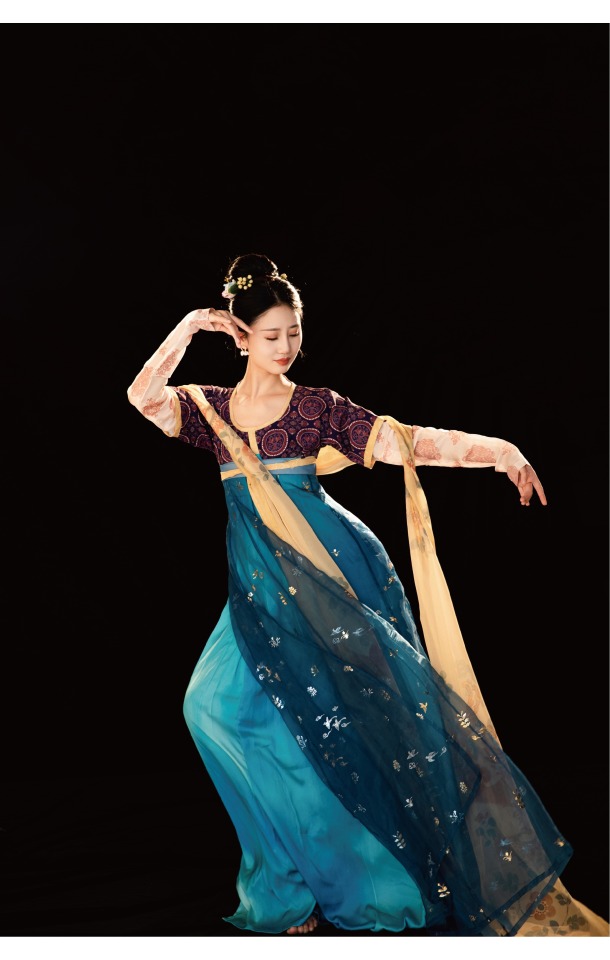

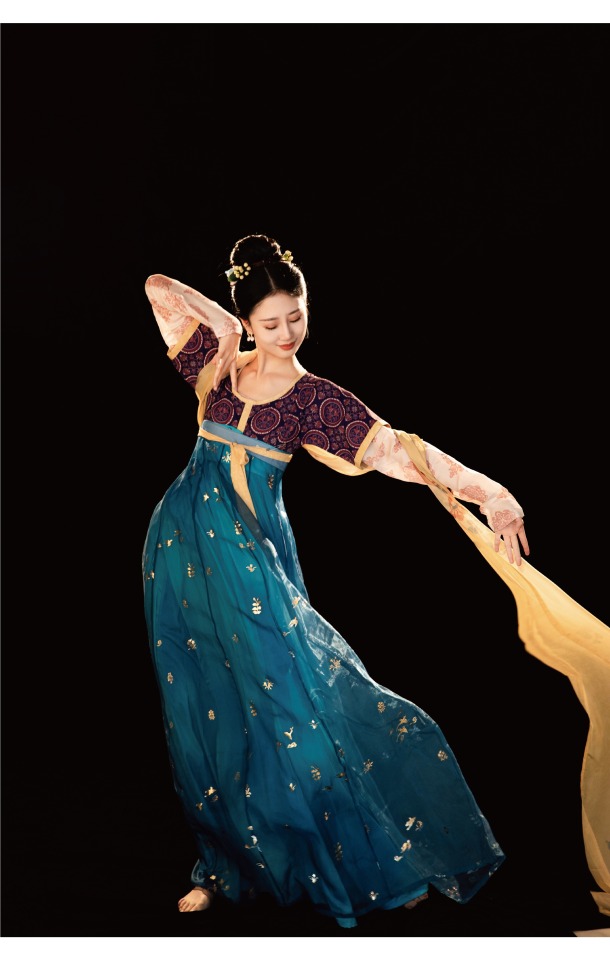

tanling qixiong by 嵠上
276 notes
·
View notes
Note
If you don’t mind me askin, do own and hafus? If not, do you have any favourites?
Hi! Thanks for the question, and sorry for taking ages to reply! (image via)

Yes, I do own a few hanfu. Here's a list of hanfu & hanfu accessories I currently own:
3 quju + 1 matching dachang
1 jiaoling (cross-collar) ruqun set (jiaoling ru + banbi + qun + pibo)
2 duijin (parallel-collar) shanqun sets (duijin shan + moxiong/dudou + qun + pibo)
1 Song dynasty-style set (beizi + shan + moxiong + baidiequn)
1 mamianqun
1 hanyuansu one-piece dress
1 pair of shoes
A few hairpins & a necklace
My favorite is probably the Song dynasty-style set by 上遥居 that I got from Nüwa Hanfu. It has a lovely color palette of lilac, pink, and white, light & ethereal fabrics, and exquisite floral embroidery & pearl accents. Perfect for spring!:
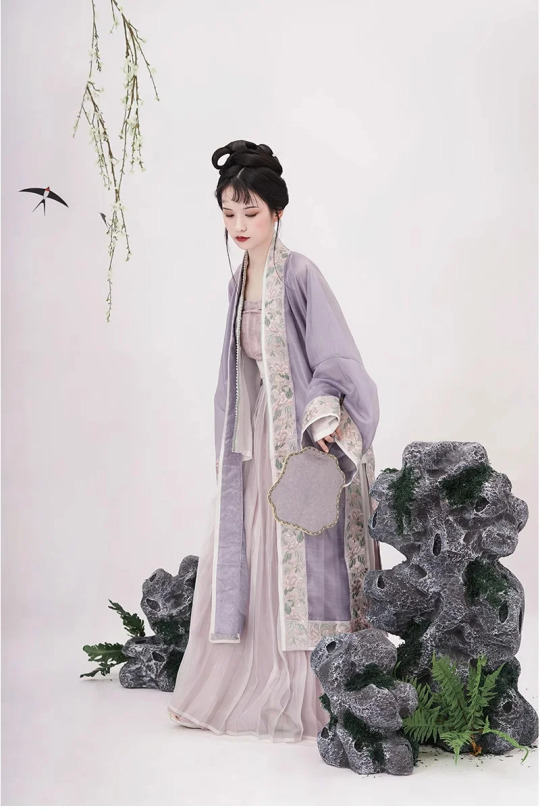
I'm also in love with this gorgeous handmade ronghua hairpin I recently got from 卿子手作 (seriously, the photos don't do it justice):

I'm looking into getting a bag next, since I realized I don't really have a matching bag to wear with my hanfu. In particular, I've been eyeing this cute embroidered swallow-motif crossbody bag from 瞳莞:
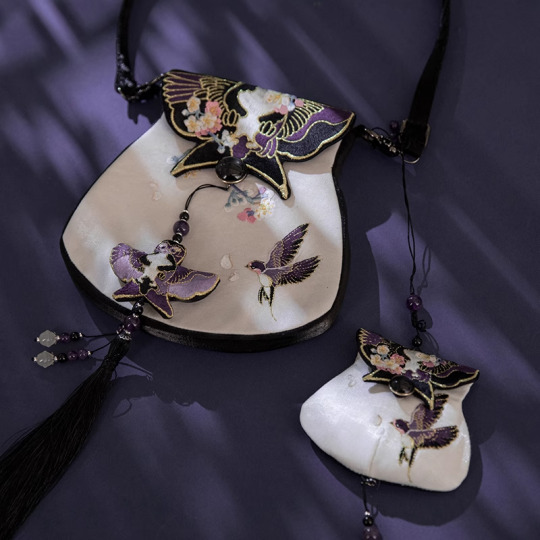
Feel free to share favorite hanfu acquisitions in this post! ^^
#hanfu#hanfu accessories#personal#ronghua#bags#hanfu recommendations#>100#ask#reply#chinese fashion#chinese clothing#china
114 notes
·
View notes
Text
Cultural Fashion: The Razor Pt. 2 - Clothing

Since the girl representing the archetype of “The Razor” has yet to be named, I’ll simply be referring to her as “Razor” for this post.
While previous Avatar Legends characters I’ve analyzed have designs that allude to less prominent cultures in ATLA, Razor’s design calls back to a more popular source of inspiration for Avatar: China’s Tang Dynasty (618-907).
Her dress comes from the Tang Dynasty--- although it’s modified to accommodate her bending. Like the women in the painting, she wears a qixiong ruqun (齊胸襦裙) or “chest high robe-skirt”. As the name implies, the flowing skirt is worn at the chest and over the robe. It’s held in place by a sash and cord combo. The final component of the outfit is the thin scarf wrapped around the arms called a pibo (披帛).
As you can see, Razor’s outfit takes some artistic liberties with its inspiration. The sash is tied under the bust, rather than over the bust, allowing the top of the skirt to peek out; this gives her a more empire waist silhouette, rather than a traditionally tubular one. Her skirt is ankle-length rather than floor-length, for ease of movement. Her pibo is weighted at both ends, which just looks awesome. Maybe she can use the rings as weapons? Like slapping people with them. Finally, and most obviously, her sleeves are cut short to accommodate both her disability and her bending ability. Overall, I really enjoy her design.
According to Avatar Wiki, Razor was raised to be a weapon, a tool for her master to use against enemies. But she saw a better way forward, and now seeks to make up for the terrible things she has done and was taught to do. When you take into consideration both her backstory and character design, she gives off the impression of a deceptively cultured assassin-type. I also just love the contrast between her brutish body language and her delicate dress.
I actually think her character embodies the spirit of the Tang Dynasty really well. It was a time of much opulence and high fashion, but it was also a period of relative freedom and empowerment for women. It was during this dynasty that China saw its first and only sovereign female emperor, a princess became a successful general to an army of 70,000 men, rough contact sports like polo were all the rage with noblewomen and women’s social & political rights were expanded. It just goes to show that a love of beauty and fashion doesn’t invalidate a woman’s strength and competence.
#avatar#atla#Avatar The Last Airbender#avatar legends#earth kingdom#Avatar Legends keeps coming at me with the A+ designs#cultural fashion
347 notes
·
View notes